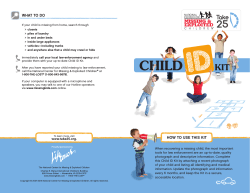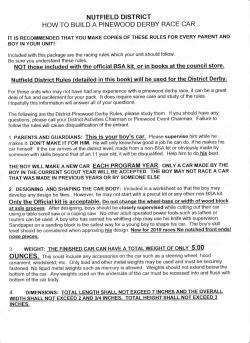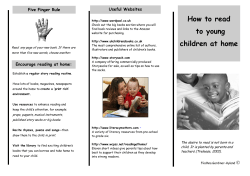
Personal Preparedness for AT Users
Personal Preparedness for AT Users Webinar series brought to you by the Washington Assistive Technology Act Program (WATAP) and the Washington Access Fund Introductions WATAP staffers: 2 Samantha Murphy – Program Specialist Gaby de Jongh – Training Coordinator and Assistive Technology Specialist About WATAP Washington Assistive Technology Act Program Low cost and Free Services: Partnership with the Washington Access Fund 3 Device Demonstrations Device Lending Reutilized Equipment Public Awareness AT Training Technical Assistance Alternative Financing Housed at the Center for Technology & Disability Studies program at the University of Washington How WATAP can help Recognizing functional needs Informed decisions with AT purchases Inclusive to Washington residents of all ages with any disability Services are available as many times as needed 4 ‘Part of preparation should be moving people from the liability side of the ledger to the asset side – minimizing the problems that they are going to encounter.’ - Marcie Roth, Director Office of Disability Integration & Coordination/ FEMA 5 Why Prepare? Emergencies and disaster happen with little to no warning, preparation means personal empowerment. Common emergencies include fires and power outages which can be the result of accidents, earthquakes, snow or ice storms and high winds. Some emergencies give you time to prepare and make provisions but most require that you already have a plan and provisions in place. 6 How and when do we start to talk about the planning process? Now is always the best time to start planning and there are simple tools to help the discussion. If you are a service provider and work with AT users, incorporate personal preparedness into regular planning meetings. If you are an AT user, have a conversation with a support person. 7 The Basics: beyond the buddy system Establish a close network of relatives and friends Make sure helpers know where to find the disaster-supply kit Train people how to charge your AT and how to help you get it set up. 8 The Basics: Creating a kit A Ready Kit is a supply of items that you will need if you should have to shelter in place or rely on your own resources for a few days. This might include back up generators, emergency blankets, candles and other items for remaining in place A Go Bag has fewer items, but they are the essential ones to take with you if you must evacuate quickly. 9 Your Go Bag can be part of your Ready Kit and easily grabbed for quick departure. The Basics: Creating a kit 3-day supply of water, non-perishable food and manual can opener List of emergency contact information including your support network members in and out of the region, service providers, etc. Copies of important documents (birth certificate, passport, licenses, insurance info, proof of address) Flashlight and radio (hand crank or have extra batteries) Cash, credit cards, checkbook, ATM card White distress flag or cloth, whistle, flashlights and/or glow sticks First aid kit 10 The Basics: More about the kit Medical equipment and assistive devices (glasses, hearing aids, catheters, augmentative communication devices, canes, walkers), plus extra batteries and chargers Medications, including a list with the prescription name, dosage, frequency, doctor, and pharmacist. If medications must be refrigerated, bring a cooler with an ice pack or other coolant system Written identification of your disability-related or health condition, or medical alert tags or bracelets Supplies for a service animal including food, identification tags, proof of vaccinations, and veterinarian contact information 11 The Main Message Have a comprehensive list of all the AT used (home, work, school) Maintain current records of products and peripherals (manufacturer/vendor; make and model; serial number; payment source) Keep AT information (including current evaluations, Rx, product information) in a safe place with other healthrelated information 12 The Message to AT Users 13 Develop a tip sheet for the products you use, in the event someone unfamiliar with your AT will need to assist you; keep this with your other documentation. Register the products Label the AT and all peripherals Have extra batteries, chargers in your “go kit” Have a “back up plan” – DIY or low tech solutions Know where you may get AT for use after an emergency/disaster (e.g., short term loans; openended/reuse programs) Planning Tool for AT This easy to use tool was adapted by the Pass It On Center from a tool developed by the Inclusive Preparedness Center. Work with a partner and follow the discussion topics to make a full evaluation of all AT used on a regular basis. http://www.passitoncenter.org/Portals/passitoncenter/Sum mitResources/Disaster%20Guide%20%20AT%20Supplment.pdf 14 Planning Tool for AT 15 Varying Needs in Preparing for Disaster There are some great resources available through public and nonprofit organizations. Inclusive Preparedness Center http://inclusivepreparedness.org/ National Organization on Disability http://nod.org/research_publications/emergency_prepare dness_materials/ Department of Health http://www.doh.wa.gov/phepr/default.htm ADA Center NW http://www.dbtacnorthwest.org/_public/site/files/Emergen cyPrepard.pdf 16 Tips for People with Battery Dependent Devices Some examples of battery dependent devices include respirators, power wheelchairs, communication devices. Keep instructions for all devices, including back up power products in a waterproof container. Have non-battery power options as back when appropriate or possible. These tips, a checklist and personal stories can be found at: http://www.jik.com/Power%20Planning%2010.24.09.pdf 17 Back Up Power Supply Chargers for wheelchair and scooter batteries that give a slow charge so batteries are ready to go. $109.00 Options for recharging wheelchair battery through a car cigarette lighter. $85.00 http://www.chargingchargers.com/wheelchair-scooter-chargers.html 18 Back Up Power Supply Rechargeable power supply. Holds charge for 6 months can receive power through AC, solar or car charger. Output power through USB, AC, 12V DC $159.99 http://www.spheralsolar.com/products/Escape-150Battery.html 19 Back up Power Supply for Devices AM/FM, shortwave, weather band radio with flashlight and adjustable reading light. Powered by hand crank, AA battery, Built in adjustable solar panel and AC adapter Can provide a charge to mobile devices using USB out jack $49.99 http://beprepared.com/product.asp?pn=CM%20R975&sid=AM AZONADS 20 Tips for People with Mobility Impairments If you use a manual chair pack heavy gloves in a go kit to help you get over glass or debris. If you don’t have puncture resistant wheels keep a patch kit on hand. For more information: http://www.doh.wa.gov/phepr/handbook/hbk_pdf/mobility. pdf http://www.nod.org/assets/downloads/Readiness-TipsMobility-Disabilities.pdf 21 Evacuation Methods Talk to your support network and train as many people about the best way to assist you in evacuation Some methods may take more than one person There are devices that can be used for building evacuation but not all buildings have them, educate facility managers ahead of time. Find the safest way to get out of the building and plan how you will get around if your wheelchair is left behind. For more tips and information: http://www.dbtacnorthwest.org/_public/site/files/Emergen cyPrepard.pdf 22 Evacuation Chairs Specially designed to transport people with physical disabilities down stairs. Extra handles in front for two person operation in locations with difficult access and for stair ascent. Some evacuation chair companies request a call for a quote. Range in price from $1,800 - $3,200 23 Evac-Aide Emergency Evacuation Blanket Fire resistant, heavy gage, rip-stop vinyl. Four hand loops on each side and S hooks in corners. Can be used as stretcher, lifter, drag surface or slide/chute. http://www.ewss.org/gpage16.html $84.00 24 Tips for people with vision impairments 25 Have an extra pair of glasses packed in your go kits. Keep eyeglass next to the bed within easy reach if you need to evacuate the home in a hurry. For more information and additional tips check out these resources: http://www.doh.wa.gov/phepr/handbook/hbk_pdf/visual.pdf http://www.nod.org/research_publications/emergency_prepare dness_materials/for_people_with_sensory_disabilities/ Tips for People with Hearing Impairments Have hearing aids close at hand, maybe in a container next to the bed for easy access. Know how to communicate with emergency responders if there is not an interpreter available. Pack pen and paper in your go kit. Use an app for video relay with a friend or family member out of the area. Have pre-printed cards you can hand to people in a hurry. “I speak ASL and require an ASL translator.” “If you make an announcement I will need it written down or signed.” http://www.doh.wa.gov/phepr/handbook/hbk_pdf/hearing. pdf 26 Fire Alert for Deaf Shake up smoke detector Wireless, single function system that detects smoke and transmits a signal within 100 feet Uses a bed vibrator to wake you up http://www.assistech.com/cgibin/shopper.cgi?preadd=action&key=SCSHKUPV $270.00 27 Fire Alert for Hearing Impaired and Deaf Receives the sound from existing T3 fire alarms. Will alert with a square-wave alarm sound, flashing “FIRE” on clock face and bed shaker http://www.hearworldusa.com/products/Lifetone-HL-BedsideFire-Alarm-and-Clock-w%7B47%7DBed-Shaker.html $149.00 28 Radio Alert System NPR Labs and Townsen University have been working to develop a system for low vision, blind, and deafblind individuals that will relay emergency alerts via HD radio. Personalized Audio Information System (PAIS) Captioned Braille Radio Initiative http://www.nprlabs.org/research-ar.html 29 Weather Alert Radio Special receiver that tunes to the 24/7 National Weather Service broadcasts with S.A.M.E. Digital Weather/Hazard AC powered with 4 AA battery back up Alerts via loud tone, LED “alert” message Can transmit signal to remote receiver in other rooms, to bed shaker or lamp http://unitedtty.com/store/product337.html $139.95 30 Tips for AAC Users Consider having a low-tech back-up to your communication device that doesn’t require power or will run off of batteries. Know how you will communicate with emergency responders if you do not have your communication device or it has run out of power. Consider using pre-printed cards 31 “I use a communication device to speak. I can understand you but I can not respond by voice.” Emergency Communication 4 All Developed by Temple University, this paper communicator can benefit people AAC user, people for whom English is a second language, people who are deaf or who have difficulty with speech output. Contact information is listed on the back of the communicator Practice using this tool often as part of emergency drills Free to download http://www.disabilities.temple.edu/aacvocabulary/e4 all.shtml#index 32 Emergency Communication 4 All 33 Emergency Communication 4 All 34 Talking Fire Alarm Battery operated, wirelessly interconnect multiple alarms Eleven pre-programmed voices will alert where the hazard is coming from “Warning! Evacuate! Smoke detected in kitchen.” http://www.firstalertstore.com/store/products/sco501cn3st-onelink-wireless-talking-battery-operated-smoke-andco-alarm.htm $69.00 35 Recordable Voice Talking Alarm KidSmart Vocal Smoke Alarm useful for people who respond poorly to normal beeping of an alarm. Able to record personalized massage in a familiar voice http://www.redi-exit.com/talking-smoke-alarm-p10.html?gclid=CLKCysmFgK4CFacbQgodW1Aa3g $41.99 36 Tips for Service Animals Service animals may not need a power supply back up but they will need planning for as well. Go kits should include food, water, medication and bowls for animals. Boots can help protect animals feet from possible debris on the ground. For more tips and information: http://www.nod.org/assets/downloads/Readiness-TipsOwners-Pets.pdf 37 Recovery - Replacing lost or damaged equipment If purchased with Medicaid contact the vendor where equipment was purchased they should know the process. If you need additional assistance: DME Authorization line: 1-800-562-3022 38 Most requests can be handled over the phone. Recovery - Replacing lost or damaged equipment Device reuse organizations 39 Can loan equipment for short or long term accommodation until equipment is replaced by other sources or for people injured in an emergency. Reuse organizations can also be used to replace equipment. Recovery - Replacing lost or damaged equipment The EverGREEN AT Exchange Online, third party exchange to post and search available devices in WA http://greenat.watap.org Pass It On Center 40 Search for reuse organizations nationally or in WA http://passitoncenter.org/locations/SearchResults.aspx NOAA Provides latest information from the National Oceanic and Atmospheric Administration View Satellite images Need WiFi or 3G for App to update information Free 41 FEMA Checklist for creating a Ready Bag and Go Kit Links for starting the recovery process Need WiFi or 3G for updated information Personal contact information General information about emergency planning and recovery. Shelters that are open Free 42 Red Cross: Shelter View Provides a list or map view of open shelters and will update every 30 minutes in a disaster. Works with Voice Over in list view. Need WiFi or 3G to operate app Free 43 WATAP contact information http://watap.org/ (800) 214-8731 Toll-Free Hotline (866) 866-0162 Toll-Free TTY (206) 685-4181 Local Voice (206) 616-1396 Local TTY (206) 543-4779 Local Fax watap@uw.edu 44
© Copyright 2025





















